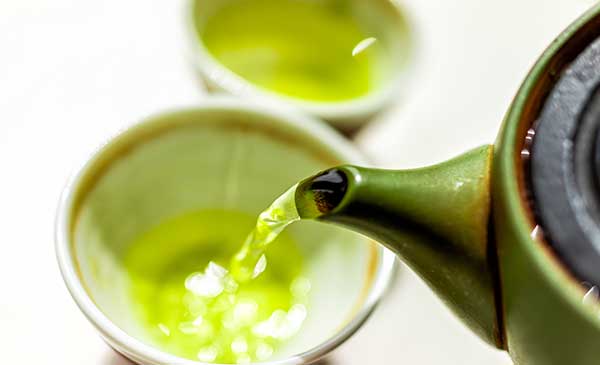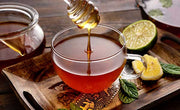Is Green Tea Acidic? Or is Green Tea Alkaline?

Being aware of acidity levels in the food and beverages we consume is important. Some researchers claim that consuming items with too much acidity can be bad for our health. Acidic food and drink can cause inflammation, heart disease, obesity, diabetes, and chronic pain.
But before you head out on a mission to avoid or eliminate acidic items from your diet, do your research. Learn what pH levels are and which foods are acidic or alkaline. This can help you decide whether avoiding acidic foods is beneficial to you or not.
How much acidity is safe in tea?
Acidity levels are measured on a pH scale. High acidity means it has a low pH value, while a high pH value means the tea is more alkaline.
A pH level of 7 is considered the perfect balance of acidity and alkalinity. Important to note: the pH level of most teas is neutral and negligible.
Is green tea acidic or alkaline?
The level of acidity in tea varies depending on the type of tea. Each type of tea has different degrees of alkalinity and acidity.
Because Japanese green teas are steamed they tend to be slightly less acidic. The steaming process preserves more of the natural antioxidants and amino acids. This also results in a milder flavor profile compared to pan-fired Chinese green teas.
But the question remains. How acidic is a cup of green tea?
Average pH Level Green Tea: A Comparison
- Black tea: pH4.99-5.55
- Oolong tea: pH5.9-8.2.
- Herbal tea: pH6-7
- White tea: pH6.9-9.7
- Green tea: pH7-10
Based on this, green tea leans more towards being alkaline rather than acidic.
Many of us have become tea drinkers because of the attraction of the health benefits. Research has indicated that the antioxidants in green tea can help regulate the body's pH balance. This enhances general health. Green tea is a great choice for those looking to improve their health and well-being.
What controls the acidity of green tea?
Whether green tea is acidic can vary based on several factors. Four key elements may influence the acidity level of green tea.
Time and Temperature
The brewing process plays a crucial role in determining the pH of your tea. After five minutes of steeping, tea starts releasing more acid compounds and tannins. The level greatly increases after 15 minutes of steeping. This results in the tea having a more bitter or astringent flavor.
Brewing tea for shorter durations at lower temperatures produces a gentler flavor. Luckily, most loose-leaf teas don't require a long steep and taste best when steeped between 2-5 minutes.
So how long should you steep green tea?
Brew time is crucial for green tea leaves. Some delicate Japanese steamed teas should only be steeped for 20-30 seconds. Jasmine Pearls, however, requires four minutes for the buds to fully open.
Use this reference chart for general recommended steeping times for loose leaf tea.
Water temperature is also key to the perfect cup of tea. Brewing black tea with almost boiling water is acceptable. Using the same temperature for green tea can transform even the freshest tea into a bitter brew. We recommend steeping green teas in simmering water, around 150° to 180°F.
Water Quality
The quality of the water you use when brewing tea can also impact acidity levels.
Because it contains dissolved minerals (such as calcium and magnesium) hard water is more alkaline than soft water. The presence of these minerals in the water raise the pH level. In comparison, soft water that has these minerals removed becomes more acidic.
Your best option is to use purified or filtered water. This can help control the mineral levels while providing a more consistent tea flavor.
Tea Leaf Age and Quality
The freshness of the tea also has an affect on acidity. High-quality teas are typically more fresh. This is why they produce a brighter, more complex flavor profile. The flavor you experience is well balanced between acidity and sweetness.
Lower quality or older teas become less balanced, and produce a more acidic flavor.
Would you like cream or sugar with your tea?
What you add to your tea can also impact the acidity level.
Adding that squeeze of lemon, drizzle of milk, or sweeteners, also may alter the acidity. We all know citrus is acidic, so it makes sense that adding it to tea would also make the tea more acidic.
However, milk will slightly increase the pH level, making your tea taste less acidic. Sweeteners like honey or sugar serve as neutralizing agents. They balance out the acidic flavor.
Two green teas with the lowest acidity are Hojicha and Genmaicha.
Hojicha is a roasted Japanese green tea. The green tea leaves are roasted in a porcelain pot over charcoal. This method prevents oxidation and produces a beautiful reddish-brown color. The resulting flavor is nutty and slightly smoky, with a hint of natural sweetness.
Genmaicha is also a tender Japanese green tea blended with toasted, popped brown rice. The popped rice reduces the astringency of the Sencha green tea and creates a sweet and nutty flavor. Genmaicha is considered an easy-to-drink green tea.
Does green tea stain your teeth?
Since green tea is more alkaline than acidic, its likely that other foods we regularly consume are probably more guilty of teeth staining.
The acid found in food such as citrus fruits, candy, soft drinks, tomato sauce, wine, and vinegar weakens tooth enamel. This makes your teeth susceptible to staining. The higher level of acid in coffee versus tea can also weaken the enamel. Drinking coffee can change the mouth's pH balance, making your teeth even more vulnerable to stains from other foods.
Some studies suggest that adding a splash of milk or cream to your tea may reduce the tendency of green tea to stain your teeth. Raw veggies can also create a protective oral environment that may help protect teeth from staining. It's also a good habit to brush your teeth afterward to help reduce the risk of staining.

What does green tea taste like?
The flavor of green tea varies based on the variety. When drinking green tea, you may describe it as floral, grassy, or earthy. Green tea blends however can produce flavors that are spicy, nutty, minty, or buttery.
If you feel green tea is too grassy or bitter, double-check your steep time. Both temperature and steep time may be causing the bitterness.
Is green tea good for acid reflux?
Green tea may even be beneficial for acid reflux. If you are prone to high stomach acidity, green tea may help soothe the digestive system and reduce the symptoms of acid reflux.
However, acid reflux triggers can vary from person to person, so pay attention to your body's response. If you notice that green tea worsens your acid reflux symptoms, it's best to consult with your healthcare provider.
Does green tea expire?
How long does green tea last? All teas, if not stored properly, can lose aroma, color, and flavor over time. As a more delicate leaf than other teas, the shelf life of green tea will be shorter if stored improperly.
To maximize shelf life, keep oxygen and sunlight out by using an airtight seal to store your tea. When stored properly, you can enjoy green tea for more than a year.






